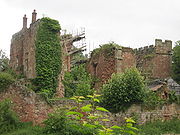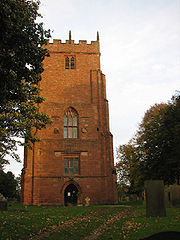
Astley Castle
Encyclopedia

_(2435223710).jpg)
Moat
A moat is a deep, broad ditch, either dry or filled with water, that surrounds a castle, other building or town, historically to provide it with a preliminary line of defence. In some places moats evolved into more extensive water defences, including natural or artificial lakes, dams and sluices...
ed fortified 16th century manor house
Manor house
A manor house is a country house that historically formed the administrative centre of a manor, the lowest unit of territorial organisation in the feudal system in Europe. The term is applied to country houses that belonged to the gentry and other grand stately homes...
in North Warwickshire
North Warwickshire
North Warwickshire is a local government district and borough in Warwickshire, England. The main town in the district is Atherstone where the council is based...
. It has been listed as a Grade II* listed building since 1951 and as a Scheduled Ancient Monument
Scheduled Ancient Monument
In the United Kingdom, a scheduled monument is a 'nationally important' archaeological site or historic building, given protection against unauthorized change. The various pieces of legislation used for legally protecting heritage assets from damage and destruction are grouped under the term...
since 1994. It has been derelict and sadly neglected since it was severely damaged by fire in 1978 whilst in use as an hotel and is officially a Building at Risk.
Early history
The Astley familyAstley Baronets
There have been four Baronetcies created for members of the Astley family, three in the Baronetage of England and one in the Baronetage of the United Kingdom. Only one creation is extant as of 2008. The Astley family were descended from Sir Thomas de Astley of Astley, Warwickshire, who was killed...
held the manor
Manorialism
Manorialism, an essential element of feudal society, was the organizing principle of rural economy that originated in the villa system of the Late Roman Empire, was widely practiced in medieval western and parts of central Europe, and was slowly replaced by the advent of a money-based market...
from the 12th century. It is not thought likely that there was ever a true 'castle
Castle
A castle is a type of fortified structure built in Europe and the Middle East during the Middle Ages by European nobility. Scholars debate the scope of the word castle, but usually consider it to be the private fortified residence of a lord or noble...
' at Astley
Astley, Warwickshire
Astley is a village and parish within the North Warwickshire district of Warwickshire, England. In the 2001 census it had a population of 219.Astley is Knebly in George Eliot's Mr Gilfil's Love Story. Eliot's parents were married in the church....
. Although a licence to crenellate the manor house there was granted in 1266, the property was only ever a fortified house.
Sir William Astley died in 1420 leaving his estate to his daughter who had married a Lord Grey of Ruthin
Baron Grey de Ruthyn
The title of Baron Grey de Ruthyn was created in the Peerage of England by writ of summons in 1324 for Roger Grey, a son of John Grey, 2nd Baron Grey of Wilton. It has been abeyant since 1963...
, a dynasty of the Welsh Marches
Welsh Marches
The Welsh Marches is a term which, in modern usage, denotes an imprecisely defined area along and around the border between England and Wales in the United Kingdom. The precise meaning of the term has varied at different periods...
.
The Greys rebuilt the manor house in 1555 and most of the remains date from this time or later. The rectangular building rose to two storeys with attics above hidden by embattled parapets.
Three Queens
During the period of Grey ownership in the 15th and 16th centuries the manor was at the centre of national events. Sir John Grey married Elizabeth WoodvilleElizabeth Woodville
Elizabeth Woodville was Queen consort of England as the spouse of King Edward IV from 1464 until his death in 1483. Elizabeth was a key figure in the series of dynastic civil wars known as the Wars of the Roses. Her first husband, Sir John Grey of Groby was killed at the Second Battle of St Albans...
who after his death in 1461 went on to become Queen of Edward IV
Edward IV of England
Edward IV was King of England from 4 March 1461 until 3 October 1470, and again from 11 April 1471 until his death. He was the first Yorkist King of England...
.
Her daughter Elizabeth of York
Elizabeth of York
Elizabeth of York was Queen consort of England as spouse of King Henry VII from 1486 until 1503, and mother of King Henry VIII of England....
became Queen in 1486 upon her marriage to Henry VII
Henry VII of England
Henry VII was King of England and Lord of Ireland from his seizing the crown on 22 August 1485 until his death on 21 April 1509, as the first monarch of the House of Tudor....
. Frances Brandon, granddaughter of Elizabeth of York married Henry Grey, Duke of Suffolk
Henry Grey, 1st Duke of Suffolk
Henry Grey, 1st Duke of Suffolk, 3rd Marquess of Dorset, KG was an English nobleman of the Tudor period and the father of Lady Jane Grey.-Henry VIII's reign:...
and their daughter Lady Jane Grey
Lady Jane Grey
Lady Jane Grey , also known as The Nine Days' Queen, was an English noblewoman who was de facto monarch of England from 10 July until 19 July 1553 and was subsequently executed...
was proclaimed Queen in 1553. She, her husband and father were executed in 1554. The family were disgraced. Astley Castle was slighted
Slighting
A slighting is the deliberate destruction, partial or complete, of a fortification without opposition. During the English Civil War this was to render it unusable as a fort.-Middle Ages:...
and forfeited and sold by the Crown to Edward Chamberlain who restored and carried out many alterations to the fabric.
English Civil War
Astley Castle was a Parliamentary stronghold during the English Civil WarEnglish Civil War
The English Civil War was a series of armed conflicts and political machinations between Parliamentarians and Royalists...
, one of a network of small, troublesome garrisons (to the Royalists) that infested this part of the English Midlands
English Midlands
The Midlands, or the English Midlands, is the traditional name for the area comprising central England that broadly corresponds to the early medieval Kingdom of Mercia. It borders Southern England, Northern England, East Anglia and Wales. Its largest city is Birmingham, and it was an important...
, drawing upon surrounding villages for their support. According to one of the garrison muster
Muster
Muster may refer to:* Muster , a process or event for the of accounting for members in a military unit* Muster , the rounding-up of livestock* Muster , a competitive skills event held between fire departments...
lists submitted to the committee of accounts at Warwick
Warwick
Warwick is the county town of Warwickshire, England. The town lies upon the River Avon, south of Coventry and just west of Leamington Spa and Whitnash with which it is conjoined. As of the 2001 United Kingdom census, it had a population of 23,350...
, Captain Hunt and Lieutenant Goodere Hunt commanded about thirty five soldiers here in July 1644. Ann Hughes, links Astley to the "rebel towns" described by royalist propaganda broadsheets as governed by low-born tinkers, cobblers and pedlars, pointing out that Hunt was "an illiterate shoemaker" before the war, prosecuted in 1647 for 'requisitioning' a gentleman's horse. The small but active Astley garrison compares with Tinker Fox
Tinker Fox
Colonel John "Tinker" Fox , confused by some sources with the MP Thomas Fox, was a parliamentarian soldier during the English Civil War...
’s celebrated band of 7 officers and 42 troopers at Edgbaston Hall
Edgbaston Hall
Edgbaston Hall is a country house in the Edgbaston area of Birmingham, England.Early in the Civil War, Edgbaston Hall, along with Hawkesley House, now the site of a council housing estate in Longbridge, was a stronghold of Colonel John Fox, the so-called "Jovial Tinker"...
, George Kendall’s 6 officers and 21 soldiers at Maxstoke
Maxstoke
Maxstoke is a hamlet in the North Warwickshire district of the county of Warwickshire, England.-Maxstoke:Maxstoke is a small residential area.In the fields around the priory can be seen traces of medieval earthworks for fish farming and water control....
Castle and Waldyve Willington’s garrison of around 130 soldiers at Tamworth Castle
Tamworth Castle
Tamworth Castle, a Grade I listed building, is a Norman castle, located next to the River Tame, in the town of Tamworth in Staffordshire, England....
(including ‘the town company’) in accounts from July 1645 (SP 28/123/part 2).
The size of the Warwickshire garrisons varied, troops being often shifted at short notice and sent out when they were needed for scouting parties, to collect levies and to carry out raids and sieges on royalist garrisons. The muster at Astley on 9 July 1645 which lists 79 officers and 462 “horse troops” under the command of Major Hawkswell, was an unusually large gathering, with the town’s population swollen by the sudden arrival of troops from surrounding garrisons, including Edgbaston and Tamworth. Most of these horse troops were probably quartered in the village, with some of the officers and Goodere Hunt’s foot soldiers occupying the castle. (SP 28/122/part 2)
Newdigate
In 1674 the Castle was sold to the Newdigate familyNewdigate Baronets
The Newdigate Baronetcy, of Arbury, Warwickshire, was created on 24 July 1677 in the Baronetage of England for Richard Newdigate of Arbury Hall. It became extinct on the death of the 5th Baronet on 2 December 1806.-Baronets of Arbury :...
of Arbury Hall
Arbury Hall
Arbury Hall is a Grade I listed country house in Nuneaton in Warwickshire, England, and is the ancestral home of the Newdigate family, later the Newdigate-Newdegate and Fitzroy-Newdegate families....
and became their secondary home. It was the home of Lieutenant General Edward Newdigate Newdigate until his death in 1902.
Decline and Restoration

English Heritage
English Heritage . is an executive non-departmental public body of the British Government sponsored by the Department for Culture, Media and Sport...
, the local authority and the Landmark Trust
Landmark Trust
The Landmark Trust is a British building conservation charity, founded in 1965 by Sir John and Lady Smith, that rescues buildings of historic interest or architectural merit and then gives them a new life by making them available for holiday rental...
have been working on possibilities which as of 2007 have produced realistic expectations that the restoration can begin in 2008.

